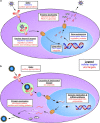Antiviral RNAi therapy: emerging approaches for hitting a moving target
- PMID: 16177819
- PMCID: PMC7091878
- DOI: 10.1038/sj.gt.3302645
Antiviral RNAi therapy: emerging approaches for hitting a moving target
Abstract
The field of directed RNA interference (RNAi) has rapidly developed into a highly promising approach for specifically down regulating genes to alleviate disease pathology. This technology is especially well-suited to treating viral infections, and numerous examples now illustrate that a wide range of viruses can be inhibited with RNAi, both in vitro and in vivo. One principle that has arisen from this work is that antiviral RNAi therapies must be tailored to the unique life cycle of each pathogen, including the choice of delivery vehicle, route of administration, gene(s) targeted and regulation and duration of RNAi induction. Although effective strategies will be customized to each virus, all such therapies must overcome similar challenges. Importantly, treatment strategies must compensate for the inevitable fact that viral genome sequences evolve extremely rapidly, and computational and bioinformatics approaches may aid in the development of therapies that resist viral escape. Furthermore, all RNAi strategies involve the delivery of nucleic acids to target cells, and all will therefore benefit from the development of enhanced gene design and delivery technologies. Here, we review the substantial progress that has been made towards identifying effective antiviral RNAi targets and discuss strategies for translating these findings into effective clinical therapies.
Gene Therapy (2006) 13, 532-540. doi:10.1038/sj.gt.3302645; published online 22 September 2005.
Figures

References
Publication types
MeSH terms
Substances
LinkOut - more resources
Full Text Sources
Other Literature Sources
Medical

